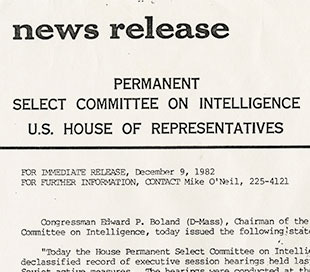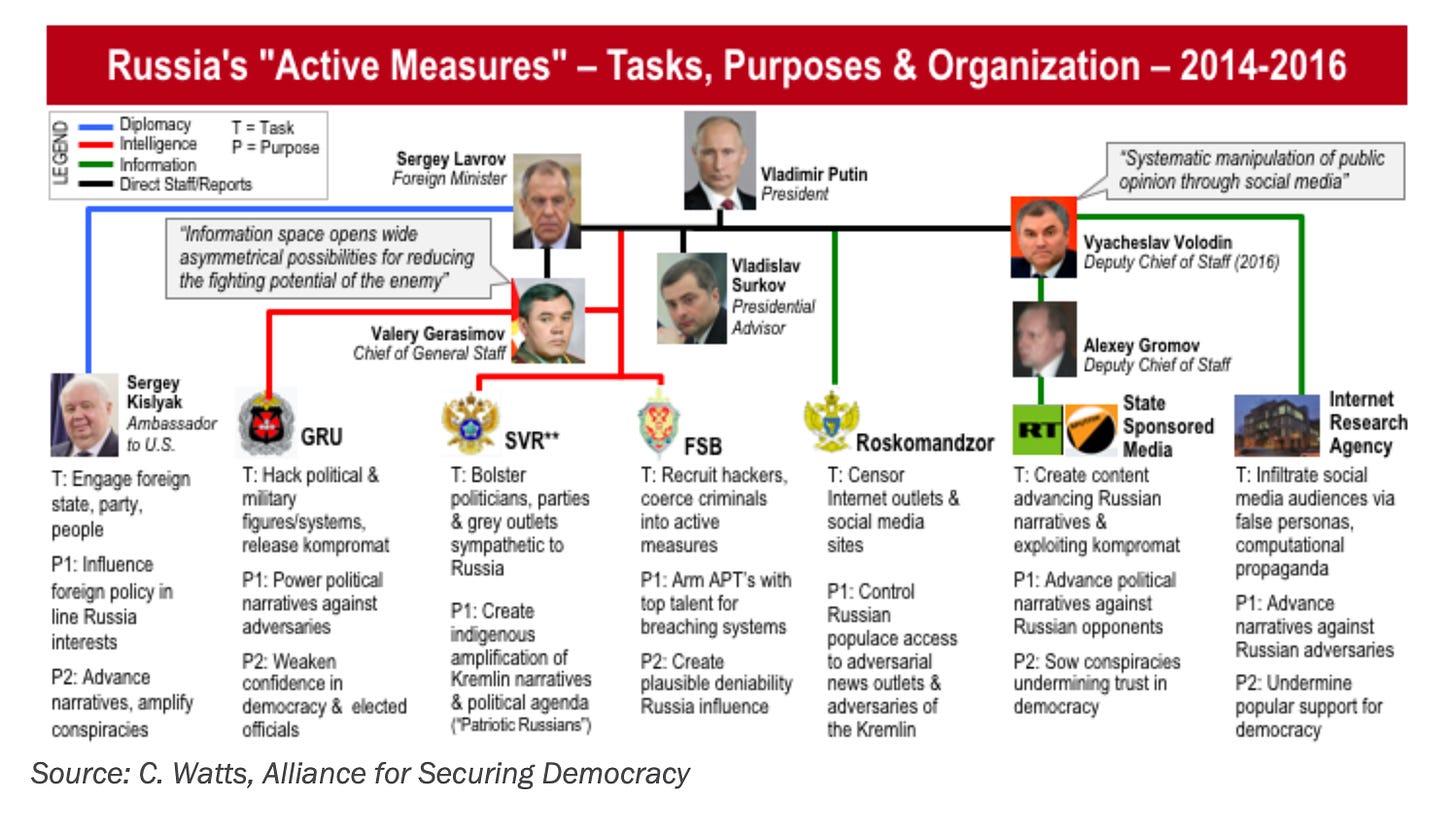Class 7. This Isn't Our First Rodeo
The 1982 congressional hearings about Soviet active measures sound like they could have taken place five years ago. Where is Russia today in comparison?
When I was putting together my syllabus for my Yale class six years ago, my friend
(who also writes an excellent Substack, ) suggested a bunch of historical material, including the 1982 congressional hearings on Soviet active measures.I remember reading the transcript, gobsmacked: We had been through this whole thing before, and haven’t learned a damn thing. Consider the following excerpt from the Interagency Intelligence Study contained in the appendix to the transcript:
A. Main target: The United States
The Soviet leadership sees active measures as an indispensable adjunct to
the conduct of foreign policy by traditional diplomatic, military, and other means. The basic aims of active measures operations are to weaken the opponents of the U.S.S.R. and to create a favorable environment for advancing Moscow's views and international objectives worldwide. The United States, which the Kremlin has considered as the "main enemy" of the Soviet Union since the early days of the post-World War II period, remains the main target of active measures. This situation has not changed in recent years despite a period of East-West detente.Although tactics may change to correspond to changed circumstances over
time, Soviet active measures tend to retain certain long-term strategic objectives:
To influence both world and American public opinion against U.S. military,
economic, and political programs which are perceived as threatening Soviet
objectives.To demonstrate that the United States is an aggressive, "colonialist,"
and "imperialist" power.To isolate the United States from its allies and friends and discredit those
that cooperate with it.To demonstrate that the policies and goals of the United States are incompatible with the ambitions of the underdeveloped world.
To discredit and weaken U.S. intelligence efforts — particularly those of
the CIA — and expose U.S. intelligence personnel.To create a favorable environment for the execution of Soviet foreign
policy.To undermine the political resolve of the United States and other Western
states to protect their interests against Soviet encroachments.
Sound familiar? How about this response from the Deputy Director of the CIA, John McMahon, to Representative Romano Mazzoli (D-KY), who asked whether the United States was responding in kind:
We are late players to that game, Mr. Mazzoli. We certainly try to counter it, and I have noted some of the gestures — and that is all they are, are gestures — that are being taken through our embassies. But we are dealing with a $3 billion to $4 billion program that the Soviets have, and we are hitting it with a flyswatter when we ask the Ambassador to do something…. So we are behind the power curve in trying to counter that, and even though we are on the side of the angels, the bad guys are winning.
We were “late to the game”…forty years ago. (It’s worth noting that the 1982 hearings were actually the second congressional discussion on how to respond to Soviet active measures — the first involved the debate around the creation of The Freedom Academy in the 1960s, which I described in the post launching this Substack. So actually we’ve pretty much known what was up and haven’t done anything about it for oh, sixty years. No biggie.)
So yeah, it’s Groundhog Day. As noted when I sent the assignment, the entire transcript, intelligence assessment, and exhibits are worth looking through, just to get a historical sense of how the U.S. perceived Soviet efforts as they were happening. It’s sort of the flip side of Yuri Bezmenov’s lecture. But what I think is the most interesting — and relevant to our disinformation landscape today — is the intelligence community’s assessment of the strengths and weaknesses of Soviet active measures (found at pp. 47-50 of the transcript). These help illuminate the asymmetries which Russia exploits, a topic that I will delve into further in a couple of weeks. It’s therefore worth going through them, one by one, and look at whether Russia still enjoys the same advantages and disadvantages today. So let’s get to it.
Strengths of Soviet Active Measures — Do They Still Exist Today?
1. Able and willing to devote financial and personnel resources for full implementation of operations
Check. As the quote above indicates, the U.S. intelligence community estimated that the Soviet Union spent approximately $3-4 billion on their active measures operations. That was in the 1980s. Fast forward to 2016: The Internet Research Agency, Russia’s troll farm, was running on a monthly budget of about $1.25 million, according to the indictment filed against the IRA and others by Special Counsel Robert S. Mueller in 2018. A separate indictment against the IRA’s chief accountant, Elena Khusyaynova, estimated that “Project Lakhta” — the influence operation for the 2016 election and the 2018 midterms — spent about $35 million between January 2016 and June 2018.
It’s worth emphasizing that these influence operations have become cheaper, since they can be conducted remotely, and online. In any event, the amount spent by Russia is more than what the U.S. was doing to combat these efforts in that same time period: The Global Engagement Center (GEC), which was created to counter foreign propaganda and disinformation, was allocated $120 million and had spent exactly $0 as of March 2018. A recent Office of Inspector General report on the GEC listed its 2020 budget at approximately $74 million — but also highlighted that it had major organizational problems and was more or less a hot mess.
2. Able to marshal all sectors and mass organizations in support of its efforts
Check. As explained by former CIA officer John Sipher in his guest lecture, Russia uses both government and non-government entities in pursuit of its efforts. The Internet Research Agency is an obvious example — technically it is a private company owned by a Russian oligarch, Yevgeny Prigozhin. (Incidentally, Prigozhin also owns the Wagner Group, who are private mercenaries supporting Putin’s war in Ukraine, illustrating that the public-private partnership extends into war.) Further, Russian intelligence services recruit the talents of criminal hackers to assist them in their operations. This chart by former FBI agent Clint Watts offers a helpful schema on how Russia funnels its various sectors into a collective effort (note that some individuals and roles may have since changed.)
3. Can create new domestic organizations within enemy state
Check. Of course, “organizations” in the digital age can exist in cyberspace, which is what Russia created on Facebook leading into the 2016 election. A great example was the “Tennessee GOP” account, a fake account with over 100,000 followers that purported to belong to Tennessee Republicans and but was actually run out of St. Petersburg. Former President Donald Trump even tweeted a “thank you” to the account before it was finally suspended in 2017, in response to a tweet that said, “We love you, Mr. President.”
Keep reading with a 7-day free trial
Subscribe to The Freedom Academy with Asha Rangappa to keep reading this post and get 7 days of free access to the full post archives.





